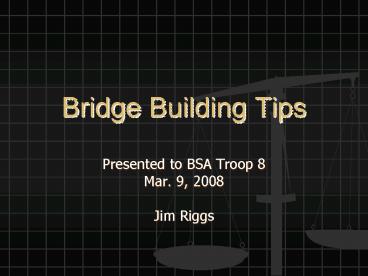Bridge Building Tips PowerPoint PPT Presentation
1 / 23
Title: Bridge Building Tips
1
Bridge Building Tips
- Presented to BSA Troop 8
- Mar. 9, 2008
- Jim Riggs
2
Overview
Todays discussion will cover
- Column Strength Demonstration
- Strength of structural members
- Classification of loads
- How to calculate the strength of a member
- Bridge Designer Program Features
- How to get information about your design
- Tips on improving your design
3
How Strong is it?
- Strength is defined by how large a load (force)
can be supported without damage. - The strength of any member is determined by the
maximum amount of stress it can withstand. - The maximum stress that can be withstood depends
on the material it is made of. - How forces create stress depends on
- Shape of the material
- Direction of the load
Stress is a Vector Quantity, it has a Magnitude
and a Direction
4
Forces Create Stress
- To determine the strength of something, we have
to determine the relationship between forces and
stress.
5
Stress
- Stress is the amount of force applied to an area
Can you hold a book and a pencil in the palm of
your hand?
How about like this?
The force is the same, but the stress is not
6
Material Type
- For engineering purposes, all solid materials
behave like springs - Engineers determine the strength of materials by
testing them to measure their Modulus of
Elasticity. We call this E - The value E is a measure of how much a material
will stretch when subjected to stress. - This stretching is called Strain
7
Measuring Material Strength
- Engineers measure the strength of a material by
subjecting it to stress, and measuring how much
it strains.
Ultimate Strength
Elastic Strength
Yield Stress
Ultimate Limit
Elastic Limit
8
- You can stretch the material in the elastic
region, and it will return to its original
position.
At the Ultimate limit, it will break
Stress
If you stretch it beyond the elastic limit,
(yield stress) the material will be permanently
deformed.
Strain
9
Some Material Properties
Yield Stress (KN/m2)
E (KN/m2)
Quenched Tempered 2.0x108 485,000 High
Strength, Low Alloy 2.0x108 345,000 Carbon Steel
2.0x108 250,000 Aluminum 6061-T6 0.69x108 275,00
0 Oak 0.17x108 31,650 Concrete 0.31x108 13,760
Steel
10
Loads Classification
Tension
Compression
The force on both columns is the same magnitude,
but in different directions, so these columns
will have different amounts of stress.
P
P
P the applied load
11
Tensile Strength
- Strength of a member in tension is called its
tensile strength. - It is determined by the maximum stress the
material can handle - It does not depend on the material shape.
- Stress Force x Area
- Max. Allowable Force Area / Yield Stress
12
Cross Section Area
- Area of a solid bar
- Area of a hollow tube
Under Tension, if the area of two members is the
same, then the tensile strengths are the same
13
Compressive Strength
- The Compressive strength of a column is
influenced by its shape - The maximum compression load a column can support
without buckling is called the - Critical Column Load
P
14
Critical Column Load Equation
P
L
E Modulus of Elasticity I Moment of Inertia L
Column Length
Material
Shape
Also called the Euler Buckling Load in honor of
mathematician Leonhard Euler who was the first to
person to solve this problem (1757)
15
Moment of Inertia (I)
- The parameter I is the Moment of Inertia (MOI).
- It relates the shape to the maximum stress
- Moment of inertia is calculated relative to some
line of reference
16
Sample MOI Calculations
Y
Y
R
X
X
H
B
17
Y
- For a hollow tube, subtract I of the inside from
I of the outside
Ho
X
HI
BI
Bo
18
- For a square section, H B
Y
Y
X
X
B
BI
Bo
B
BI
Bo
19
- For a square tube with constant wall thickness,
t, the inside length is - BIBO-2t
Y
t
X
B
B
20
Sample Calculation
P
- Consider the ¼ inch Oak Column
- E0.17 x 108
- I (0.25)4 / 12
- Pcrit 17,385 / L2 (Newtons)
- (L in meters)
- Pcrit 7,980 / L2 (Lbs)
- (L in inches)
21
Sample Calculation
Critical column load Vs. length for an Oak
column 1/4 Square
22
West Point Bridge DesignerBridge Building
Checklist
- Use the Symmetry Guides
- Reduce all members to minimum size
- Use the member list
- Shorten long members that cary large compression
loads - Use the Cost Calulations report to reduce the
number of different size members - Experiment with different materials
- Experiment with different shapes (move joints)
23
Vocabulary
- Strength
- Tension
- Compression
- Stress
- Strain
- Elastic Strength
- Ultimate Strength
- Yield Stress
- Ultimate Stress
- Modulus of Elasticity (E)
- Moment of Inertia (I)
- Critical Column Load (Euler Buckling Load)

